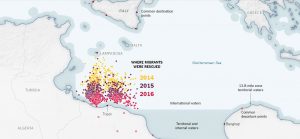Efforts to Rescue Migrants Caused Deadly, Unexpected Consequences
Strategies to rescue migrants in the Mediterranean Sea and disrupt smuggling networks have had deadly, unexpected consequences, according to aid groups monitoring the crisis.
It is part of a wrenching Catch-22: Any effort to lessen the migrant crisis can backfire as smuggling networks devise even more dangerous strategies in response. Here is how those strategies have pushed desperate migrants into even more desperate situations.
Smugglers Respond to Rescue Efforts
The bodies of 10 migrants were recovered and at least 100 more migrants were missing on Saturday off the coast of Libya. Eight of the bodies were found on an inflatable boat in the Mediterranean Sea, in a treacherous area between Libya and Italy known as the Central Mediterranean route. Each year, aid groups patrol the area and rescue thousands of migrants at risk of drowning.
Rescuing migrants closer to the Libyan coast saved hundreds of people at sea. But critics said it introduced a deadly incentive for more migrants to risk the journey and for smugglers to launch more boats.
“Migrants and refugees – encouraged by the stories of those who had successfully made it in the past – attempt the dangerous crossing since they are aware of and rely on humanitarian assistance to reach the E.U.,” said a risk analysis by Frontex, the European Union border and coast guard agency.

Smugglers use flimsy boats and provide just enough fuel to reach the edge of Libyan waters. Drivers can remove the engine and head back to Libya on another boat, leaving the migrants adrift until help arrives.
Groups monitoring the crisis expect the death toll to surpass last year’s figures. And it has done so for every month this year, until recently: A series of drownings over three days killed 700 people in May 2016.
Joel Millman, a spokesman for the International Organization for Migration, cautioned against concluding that the situation had improved. “It’s much more piecemeal,” he said, referring to the slower but steadier pace of drownings. “It’s much more dangerous. They’re putting people in much smaller boats and in greater numbers.”
While dire conditions in Libya and other African countries have played a larger role in motivating migrants to flee, aid groups have recognized how their efforts have bolstered the smuggling business model.
“We know that what we do is not the solution,” said Stefano Argenziano, operation coordinator on migration for Doctors Without Borders, which has rescued migrants near the Libyan coast since 2015. “It’s not the source of the problem, it’s not the solution to the problem. It’s the sheer necessity of saving lives now, when lives are in danger.”
Despite the criticism, there is no evidence that reducing rescue efforts would reduce fatalities. After the European Union stopped funding the Italian patrol and rescue program Mare Nostrum in 2014, a record number of people attempted the journey, and a record number of people drowned. The United Nations also supported increasing rescue efforts, saying the death toll would be higher without them.
Smugglers Downgrade as Boats Are Destroyed
Officials started destroying wooden boats used by smugglers, hoping this would disrupt the criminal networks. But this had an unintended effect: Smugglers increasingly used cheaper rubber dinghies.The European Council started sinking boats in 2015 and has destroyed more than 400 boats since then.
“The onset of anti-smuggling operations has accelerated the pace of the degradation” in quality and safety, Mr. Argenziano said.
The cheaper 30-foot dinghies are blamed for increasing the number of deaths at sea because they are unfit for long travel and prone to punctures and capsizing, according to the United Nations Refugee Agency.Roughly the size of two sedans, the vessels were designed to carry about 60 passengers. But Frontex has seen more than 150 people on any given craft. Those numbers have increased since 2015, according to Europol.
“If you have a dinghy with 170 people on board, these boats can capsize in seconds,” said Izabella Cooper, a spokeswoman for Frontex. “And it really takes seconds for people to drown. Many people who are coming from Africa have never seen the sea in their lives before.”All sides agree the solution ultimately lies in Libya and deeper within Africa, where improving conditions and opportunities could prevent people from boarding boats and making the deadly journey.
Governments have considered strategies that could discourage migrants from boarding boats at all, like an Italian agreement to train the Libyan Coast Guard so it can intercept and rescue migrants before they reach international waters.
“There’s no doubt that the situation in Libya is bad enough for thousands and thousands of foreigners and migrants” to flee, said Federico Soda, the director of the Coordination Office for the Mediterranean with the International Organization for Migration.
“It’s really time to start looking at some of the long-term policies,” he added. “Africa and Europe are always going to be neighbors. Movement of people between the two is just a reality of the coming decade.”
Related Articles
Princes and bankers and aid! Oh my!
05/26/2017. Despite external criticism and some of their own internal discomfort, more humanitarians are engaging with the World Economic Forum than ever before and see such spaces as critical for solving today’s complex crises.
Unity within Security Council vital to prevent mass atrocities – UN chief Guterres
04/18/2017. “We must collectively draw strength from the letter and spirit of the Charter to better prevent armed conflict and sustain peace through development [by] ensuring effective protection of all human rights – civil, political, economic, social and cultural,”
Diplomacy Then and Now: Prevention is Always Better Than Treatment
30/21/2017. Aid workers and healthcare providers working amidst the ravages of war understand all to well the crucial importance of stopping conflict through diplomacy and negotiation.






